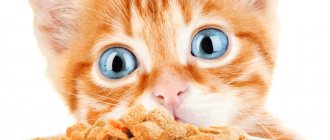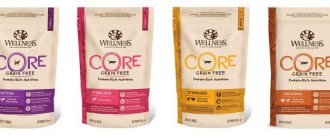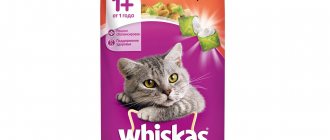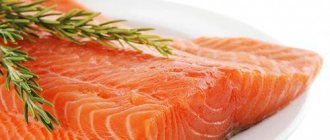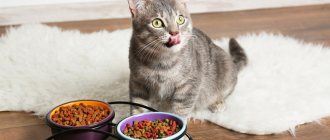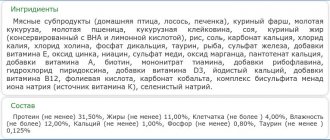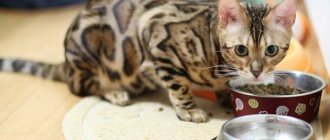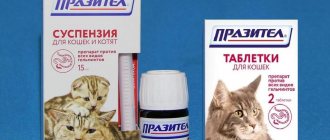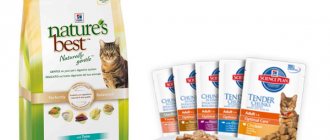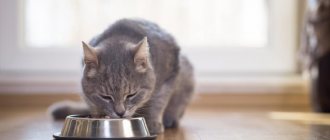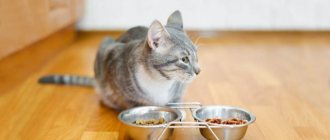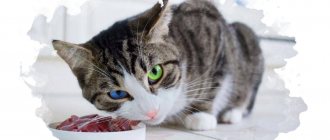General characteristics and key aspects:
- There is a great variety of gastroenteritis in small domestic animals, and it is not always possible to determine the cause of the condition. Minimum set of tests: TCA, total protein, blood glucose, acid-base and electrolyte composition of the blood.
- Clinical signs of acute gastroenteritis typically include vomiting, diarrhea, and partial or complete refusal to feed.
- Findings on physical examination are usually nonspecific: abdominal pain, dehydration, hypovolemia.
- If the cause of the disease is unknown, symptomatic therapy is prescribed. The prognosis for most cats and dogs with gastroenteritis is excellent.
Special daily food
Wet food from the same manufacturers is ideal for daily feeding for gastritis. “Vet Solution Gastrointestinal” from “Monge” to them .
If the veterinarian has not prescribed another feeding option, then you can use the following scheme calculated by the manufacturer:
| Cat weight | Daily feed intake | Number of meals |
| 2 kg | 2/3 cans | 4-5 times a day |
| 3 kg | 1 jar | 4-5 times a day |
| 4 kg | 1 1/4 cans | 4-5 times a day |
| 5 kg | 1 1/2 cans | 4-5 times a day |
Introduction
Gastroenteritis of dogs and cats
– a rather broad term meaning the presence of an inflammatory process in the stomach and intestines. It is a common cause of acute vomiting, anorexia and diarrhea, but it is worth understanding that pancreatitis, hepatitis, and intestinal obstruction can occur with similar symptoms. There are many reasons for inflammation of the gastrointestinal tract, for example, changes in diet, infectious organisms, toxins, disorders of the immune system, metabolic disorders. A history and physical examination can sometimes reveal why the inflammation started, but in most cases a specific cause is never found. Often, for complete disappearance of symptoms, symptomatic therapy, including infusion support, diet, antiemetics and gastroprotectors, is sufficient. However, in some cases, rapid decompensation may occur, usually secondary to hypovolemia, fluid loss, and thyroid hormone imbalance.
Anatomy and physiology
The stomach is a section of the gastrointestinal tract between the esophagus and the small intestine, which serves as a storage reservoir for food, and also grinds and mixes food here, which then enters the small intestine. The stomach consists of muscle layers, areas of glandular tissue and mucous membrane. With the help of muscle movements, the stomach grinds food and pushes it through the pyloric sphincter into the small intestine. The glandular areas are no less important: the parietal cells secrete hydrochloric acid, the main cells secrete pepsinogen, and the mucus-forming cells also secrete bicarbonate. Due to the barrier function of the gastric mucosa, hydrochloric acid and digestive enzymes are retained in the lumen of the stomach, which prevents the loss of plasma components into the stomach. Once the food in the stomach is sufficiently crushed, it moves through the pyloric sphincter into the small intestine, the beginning of which is called the duodenum.
The small intestine of cats and dogs is divided into the duodenum, jejunum and ileum. The mucous membrane of the small intestine performs both secretory and absorption functions and consists of a monolayer of cells - enterocytes. The mucous membrane of the small intestine along its entire length forms finger-like villi that protrude into the intestinal lumen and increase its working surface. Microvilli form a “brush border”, which further increases the surface area for better digestion and absorption of nutrients.
Brush border enzymes break down larger molecules into smaller ones that are more easily absorbed. Absorption usually occurs through special transport mechanisms or pinocytosis. Epithelial cells are also involved in the absorption and secretion of water and electrolytes. Enterocytes are tightly connected to each other to limit absorption between cells and prevent the reverse flow of nutrients - from the interstitium into the intestinal lumen. The lifespan of enterocytes ranges from 2 to 5 days; they start from the crypts (the base of the villi) and migrate towards the intestinal lumen. A healthy, intact mucous membrane plays a large role in maintaining the integrity of the intestines. Any inflammation that disrupts the integrity of the mucosa can lead to serious intestinal disease. It is important to remember that the gastrointestinal tract absorbs 99% of the water entering it, therefore, any disturbances in the functioning of the gastrointestinal tract can lead to serious disorders of the water and electrolyte balance of the body.
What is the problem: reasons
The FCoV virus, which often mutates, can provoke coronavirus gastroenteritis. Carriage of parnovirus or hepatitis also influences the progression of pathology.
In pets, the gastrointestinal tract suffers from an unbalanced diet. There are the following causes of gastroenteritis in cats:
- Incorrectly selected food and other food products. Poor quality food, spicy, hard or salty food provokes an inflammatory reaction in the internal organ of the animal.
- Hearty food.
- Negative effects of heavy metal salts entering the body of cats through food intake.
- Allergic reaction to food.
- Treatment of a pet with pharmaceutical drugs. With long-term use of antibacterial agents, the gastric mucosa is irritated and gastroenteritis occurs in the cat.
Often a pet gets sick due to salmonella entering the body.
In pets, gastroenteritis can be a consequence of hairballs entering the gastrointestinal tract. Also, liver pathology becomes a source of the problem. Inflammation may occur against the background of pancreatitis or intestinal obstruction. According to statistics, an inflammatory reaction in the area of the stomach and small intestine is more often caused by viral and bacterial infections, such as:
- salmonella;
- coli;
- various helminths, in particular isospores, coccidia.
This is interesting: Viral peritonitis in cats
History and clinical signs of inflammation of the intestines and stomach in dogs
A carefully collected anamnesis for symptoms of gastroenteritis in dogs and cats
– the basis for determining the cause of intestinal inflammation. It is necessary to ask what the patient usually eats, whether his diet has changed recently, whether he has recently had access to unusual food, foreign bodies, garbage, or toxins. It is also necessary to find out whether the patient interacted with other animals, and if so, whether these animals had similar symptoms or a history of such. In addition, when collecting anamnesis, find out the patient's vaccination status, history of deworming and use of medications.
Clinical signs of gastroenteritis
of different etiologies are similar and depend little on the cause of the disease. Diarrhea, vomiting, and anorexia are the most common symptoms, and different combinations of these signs may be more suggestive of one cause than another. Severe inflammation or ulceration of the mucosa can lead to hematemesis or melena.
Physical examination usually does not help determine the cause of the disease. You may find the patient has varying degrees of dehydration and abdominal pain. In severe cases, with parvovirus enteritis or HGE, the patient may show signs of hypovolemia and shock secondary to fluid loss and impaired blood circulation.
Natural products
To begin with, it is worth clearly indicating that natural products are those that are prepared specifically for the cat, and not those that are left on our plate after dinner. They should not contain seasonings, oil, marinades, or mayonnaise.
Natural feeding of a cat means excluding fatty, fried, smoked foods, because this is what leads to gastritis.
Products included in the diet for gastritis
An “undesirable” product will provoke an exacerbation of gastritis, diarrhea or vomiting. This can significantly aggravate the situation and worsen the pet’s well-being.
It is very important to adhere to the list of permitted products, which includes:
- boiled chicken breast;
- boiled veal (beef);
- boiled rabbit meat;
- turkey (also boiled);
- boiled sea fish fillet;
- light chicken broth;
- oatmeal and rice broth;
- yogurt without sugar and additives (from the second week of the diet);
- kefir 1% fat (from the second week, if there is no diarrhea);
- raw yolk of a chicken or quail egg (from the second week);
- raw beef (from the third week of the diet);
- raw chicken fillet (third week);
- low-fat cottage cheese (at the end of the diet)
As mentioned above, all products must be ground to a pate consistency. Raw meat is given at the end of the diet, if the pet is clearly on the mend. Milk should not be given. Food should never be of questionable freshness or quality.
Products that are prohibited
In order for the cat to be healthy and not suffer from gastritis, the following products should never get into his bowl::
- salt, sugar;
- pepper and any other spices;
- onions (it causes anemia);
- fatty meat (pork, lamb);
- bones;
- production waste – chicken feet, heads, skin;
- smoked meats;
- yeast dough and flour products in general;
- milk;
- starch.
Etiology of inflammation of the stomach and intestines in cats and dogs
Infectious gastroenteritis in small domestic animals
The gastrointestinal tract is affected by a lot of infectious agents. Viruses, bacteria, parasites, and fungi can lead to gastroenteritis of varying severity. The table presents possible infectious causes of gastroenteritis, but only the most common ones are described in the text.
Infectious causes of gastroenteritis in dogs and cats
Bacteria:
- Campylobacter spp.
- Clostridium spp.
- Escherichia coli
- Salmonella spp.
- Helicobacter spp.
Viruses:
- Parvovirus
- Rotavirus
- Intestinal coronavirus - coronavirus gastroenteritis in cats
- Feline infectious peritonitis
- Canine distemper virus
- Coronavirus gastroenteritis in dogs
- Feline leukemia virus
- Feline immunodeficiency virus
Fungi, Algae and Oomycetes:
- Histoplasmosis
- Protothecosis
- Pythiosis
Parasites:
- Roundworms (Toxocara canis, Toxocara cati, Toxascaris leonina)
- Nematodes (hookworm, uncinariasis, strongyloidiasis)
- Whipworms
- Coccidia (isospores, toxoplasma, cryptosporidium)
- Giardia
- Trichomonas
- Intestinal balantidia
Rickettsia:
- Neorickettsia helminthoeca
Viral enteritis of dogs and cats
One of the most common infectious diseases in dogs is parvovirus enteritis (CPV-2), which can lead to severe enteritis, vomiting, hemorrhagic diarrhea, and shock (Chapter 112). Also, coronavirus and rotavirus can lead to severe inflammation of the intestines, however, since these viruses affect only the upper part of the villi, the inflammation rarely reaches such proportions as with parvovirus enteritis, which affects the crypts. Thus, coronavirus gastroenteritis in cats is not uncommon. Panleukopenia, also caused by parvovirus, leads to severe gastroenteritis in cats.
Bacterial enteritis of cats and dogs
Bacteria most often causing acute gastroenteritis in cats and dogs
: clostridia, salmonella, campylobacter, Helicobacter, enterotoxigenic E. Coli. However, it is currently considered controversial that some of these microorganisms can lead to clinically significant enteritis. So far, the question of the role of clostridia, campylobacter, and Helicobacter is considered open.
Symptoms
The FCoV virus, having entered the cat’s body, “nests” on the intestinal mucosa. In the presence of favorable conditions (a decline in the animal's immunity, stress, poor nutrition), the infectious agent begins to multiply rapidly, causing inflammation of the intestinal mucosa, and then the stomach. The secretory and motor functions of the gastrointestinal tract are disrupted, and catarrh of the stomach and intestines develops.
Signs of gastroenteritis in cats are usually quite pronounced and difficult to ignore. This:
- diarrhea,
- vomit,
- poor appetite
- blood and mucus in stool
- in severe cases - elevated temperature.
The animal becomes apathetic, stops grooming itself, and has a dull look. When you try to drink water or eat something, you experience “dry” gagging.
Hemorrhagic gastroenteritis
Hemorrhagic gastroenteritis in dogs and cats
– a disease of unknown etiology. Hemorrhagic gastroenteritis typically affects young and middle-aged small breed dogs and is characterized by a subacute onset of clinical signs, rapid progression, and without appropriate treatment can lead to death. Sick animals, as a rule, did not have any complaints before. It has been suggested that the onset of the disease may be due to an abnormal immune response to bacteria, bacterial toxins, or dietary ingredients. Although C. perfringens has been isolated from the intestinal contents of animals suffering from hemorrhagic gastroenteritis, its exact role in the etiology of the disease has not yet been established.
Vomiting, depression, bloody diarrhea (often described as “raspberry jam”) and anorexia are classic symptoms of hemorrhagic gastroenteritis. Before settling on a diagnosis of hemorrhagic intestinal inflammation, rule out other causes - parvovirus, bacterial infections, parasitic diseases. Although hemoconcentration is always present, plasma protein concentration increases very little or does not increase at all. Hematocrit increases secondary to hypovolemia and splenic contraction, while losses of plasma protein in the gastrointestinal tract and redistribution of fluid from tissues into the vascular lumen explain the slight increase in total plasma protein concentration.
For this pathology, aggressive therapy is indicated, as very rapid decompensation can occur. Most of all, adequate fluid replacement is necessary. The main goals are to quickly replace the volume of fluid lost during acute diarrhea and vomiting, and then adjust the volume of fluid administered so that rehydration is gradually achieved (more on other pages of the site). It must be remembered that the intestine is a shock organ in dogs, and insufficient perfusion can lead to worsening gastroenteritis, bacterial translocation, sepsis, and disseminated intravascular coagulation. Due to the loss of plasma proteins into the intestine, special attention should be paid to colloid osmotic pressure and, if necessary, provide colloid support. In addition to infusion therapy, the administration of antiemetics and antibiotics may be required (if translocation is suspected). With timely and adequate treatment, the prognosis for complete recovery from hemorrhagic gastroenteritis is good.
Routes of infection
The FCoV coronavirus enters a cat's body orally or nasally if a particle of feces from a sick animal enters its mouth or nose. The virus can remain viable in the external environment for up to 7 days, and in the body of an animal carrier it can survive in “sleep mode” for up to a year until it receives favorable conditions for reproduction.
The disease is most often registered in cats under the age of two years, as well as in individuals older than 10-12 years. Cats kept in large groups are at greatest risk: residents of nurseries and cat shelters. Domestic cats, which have little contact with their relatives, according to statistics, account for less than 10% of cases of the total number of coronavirus gastroenteritis. The risk of human transmission of infection to a domestic cat is small, but still exists. This is possible if feces of an animal sick with coronavirus gastroenteritis gets on the clothes or hands of the cat owner.
Important! A cat sick with coronavirus gastroenteritis cannot infect a kitten through the placenta during its fetal development. But after the birth of kittens, it is recommended to isolate them from their sick mother.
Dieting
The cause of gastroenteritis in dogs (less often in cats)
The animal may absorb toxins (for example, organophosphates), foreign bodies, and debris. Some toxins directly lead to GI inflammation, while foreign bodies can lead to traumatic gastroenteritis or osmotic diarrhea (due to the presence of an indigestible substance within the GI tract). Eating foods that are too fatty can lead to pancreatitis. Medications can also cause vomiting and diarrhea: antibiotics, anti-blastoma drugs, anthelmintics. Ingested garbage can become a source of bacterial toxins. Most often, a violation of the diet leads to acute vomiting, diarrhea and anorexia. Take a thorough history: Owners should know if the animal has had access to specific toxins or debris. This diagnosis, as a rule, is hypothetical and treatment is supportive (infusion therapy, antiemetics, gastroprotectors as necessary). The prognosis is good and most animals recover within 24-72 hours.
Symptoms
Given the variety of possible causes, it is not surprising that the symptoms of gastroenterocolitis in cats are quite variable. There are a lot of them... The problem is that none directly indicate gastroenterocolitis.
As a rule, it all begins with profuse diarrhea. The cat runs to the litter box very often. A distinctive feature is the “tension” of diarrhea. It often happens that the entire backside of the animal is stained with feces, which end up outside the cat’s litter box. The animal weakens very quickly and is no longer able to put itself in order. It is especially difficult for long-haired cats, whose entire backside is “decorated” with icicles of fur, thickly stained with feces.
Fortunately, this clinical picture is more typical for a hyperacute course. As a rule, the matter is limited to prolonged diarrhea. In cases where the onset of the disease was provoked by poisoning or exposure to some infectious agent, abundant impurities of mucus and blood are often found in the stool.
Further more. When enough toxins accumulate in the body, vomiting begins. It can be very strong, the animal literally “throws you up” on the spot. The attacks are long and painful. Soon, excessive vomiting and diarrhea lead to the development of severe dehydration. The cat's eyes become sunken, the visible mucous membranes turn pale and become dry to the touch. The skin loses its elasticity, the coat becomes ruffled, and individual hairs become stiff and brittle.
Note that kittens and initially weakened, old animals do not survive to this stage , since they die much earlier from dehydration. Very often, toxic damage develops (especially in cases of poisoning) of the liver, which causes clearly visible jaundice of all visible mucous membranes and skin.
Protein-losing enteropathy (PLE)
Protein-losing enteropathy is a general diagnosis that includes gastroenteritis of any etiology resulting in excessive loss of plasma protein. The most commonly associated diseases with the term protein-losing enteropathy are: severe lymphocytic-plasmacytic, eosinophilic, granulomatous inflammatory bowel diseases, lymphangiectasia, diffuse fungal infection of the gastrointestinal tract, diffuse neoplasia, for example, lymphosarcoma. Some of the above diseases can lead to protein-losing enteropathy if the intestinal mucosa is sufficiently damaged.
Protein loss can occur due to an inflammatory process or due to a violation of the gastrointestinal barrier. Loss of proteins very often occurs due to abnormal functioning of enterocytes, as well as when the permeability of the intestinal wall between enterocytes is impaired. Clinical signs of enteropathy are often associated with chronic wasting due to lack of nutrients in the body. However, proteins such as albumin and antithrombin III, which play an important role in hemostasis processes, can also be lost through the intestine. Albumin (molecular weight 69,000 daltons) is of great importance for maintaining oncotic pressure. Loss of albumin through the gastrointestinal tract can lead to a decrease in colloid osmotic pressure, which often leads to loss of fluid from the intravascular space. Although this process usually occurs gradually, it can nevertheless lead to a significant redistribution of fluid in the patient's body, and this should be taken into account when prescribing infusion therapy. In addition to crystalloids, transfusion of colloids or human albumin may be required to prevent further fluid loss from the vascular bed. Albumin has additional positive properties - antioxidant and anti-inflammatory.
Antithrombin III plays an important role in coagulation and fibrinolysis by inactivating thrombin and other coagulation factors. Even a slight decrease in antithrombin III levels leads to a significant increase in the risk of thrombosis and thromboembolism. Patients with protein-losing enteropathy, who lose large amounts of protein, are predisposed to vascular thrombosis in the lungs, brain, and portal vein. Treatment of enteropathy often includes glucocorticoids, which also increase the risk of thromboembolism. Therefore, in such cases, the use of anticoagulants and antiplatelet agents is often justified.
Treatment of enteropathy is based on treatment of the underlying disease. Patients with diffuse neoplasia, such as lymphosarcoma, should receive chemotherapy. Patients with inflammatory bowel disease should receive anti-inflammatory therapy and a hypoallergenic diet. Lymphangiectasia can be primary or secondary, and feeding low-fat diets may be more effective than feeding hypoallergenic foods, depending on the degree of inflammation.
Special dry food
Specially developed medicinal foods greatly facilitate the process of treating gastritis. They take into account all the needs of the cat’s body during illness and contain prebiotics; All ingredients have undergone special processing, making them easier to digest.
For a therapeutic diet, wet food is better, but there are times when a cat is used to dry food and may refuse wet food. It must be remembered that when feeding dry food, the pet must drink enough water.
Some premium foods for cats with gastritis:
- Gastro Intestinal by Royal Canin;
- Pro Plan EN Gastrointestinal from Purina;
- Hill's Prescription Diet I/D.
Manufacturers recommend the following dry food feeding regimen (the daily intake is divided into several doses):
| Cat weight | Daily feed intake | Number of meals |
| 2 kg | 30 g | 4-5 times a day |
| 3 kg | 45 g | 4-5 times a day |
| 4 kg | 60 g | 4-5 times a day |
| 5 kg | 75 g | 4-5 times a day |
| 6 kg | 90 g | 4-5 times a day |
Mixing ready-made food with natural feeding is prohibited. Also, do not mix dry and wet food.
Diagnostics
The extent of diagnostic testing you perform on a dog presenting with symptoms of acute gastroenteritis depends on the patient's history, history of similar problems, and the patient's stability. Fecal testing for parasites and bacteria should be performed on all animals with acute gastroenteritis. In addition to Gram staining, culture studies can be performed. The result is considered definitively negative if at least three stool tests have been performed. ELISA tests are available to detect C. perfringens enterotoxins and C. difficile toxins A and B. Antigenic tests exist for both Giardia and parvovirus enteritis.
The examination should include clinical and biochemical blood tests, and a urine test. Typically, the results of these studies are within normal limits and do not in any way affect the final diagnosis. However, in some cases, for example, with HGE (when we see an increase in hematocrit with a normal amount of total protein) or in PLE (when we see a decrease in protein, albumin, globulin, cholesterol), test data can help in diagnosis. Electrolytes should be checked regularly to ensure adequate fluid resuscitation.
An X-ray of the abdominal cavity may not be informative, but may show fluid-filled intestinal loops. However, X-ray examination should always be performed if intestinal obstruction (foreign body or neoplasm) is suspected. Ultrasound is an excellent way to examine the abdominal organs, including the thickness and layering of the walls of the stomach and intestines. Unfortunately, the findings of an ultrasound examination may be nonspecific, and they should only be assessed in conjunction with data from other studies.
If you suspect protein-losing enteropathy, you need to take a biopsy of the patient's intestinal wall, which can be done in two ways. Endoscopy is a minimally invasive method for visualizing the mucous membrane of the esophagus, stomach and duodenum, as well as for taking small (1.8-2.4 mm) samples of biopsy material. The disadvantages of the method are that the material samples are too small and the inability to penetrate distal to the duodenum. It is possible, of course, to perform a colonoscopy to obtain samples from the ileum, but this procedure requires a cleansing enema as preparation, which can lead to decompensation of an unstable patient due to imbalance of fluid and electrolytes. Another way is diagnostic laparotomy. The good thing about this method is that you can take a biopsy through all layers in any part of the intestine (or take a biopsy of other abdominal organs if changes are found in them). The disadvantage of the method is its invasiveness, and in animals with reduced albumin levels, poor healing of the postoperative wound is possible. In addition, damaged walls of the stomach and intestines heal poorly.
The most common clinical signs of gastroenteritis are vomiting, diarrhea, and anorexia. These symptoms are characteristic of many diseases, so diagnosis is often made by exclusion. Differential diagnoses for animal gastroenteritis include diseases such as renal failure, liver disease, hypoadrenocorticism, diabetes mellitus complicated by ketoacidosis, vestibular syndrome or other neurological abnormalities, pancreatitis, pyometra, prostatitis and peritonitis. From primary gastrointestinal diseases, it is necessary to exclude intussusception, foreign body obstruction, infiltrative diseases (neoplasia, infections) and ischemia. These diseases must be excluded before making a diagnosis of gastroenteritis.
What it is?
This is the name of a severe pathology in which the cat’s digestive tract from the stomach to the final intestines is inflamed. It is accompanied by severe vomiting, profuse diarrhea, and increasing signs of dehydration and intoxication. The older or younger the animal, the higher the likelihood of death. We list the main reasons that can lead to the development of this disease:
- Food poisoning. This is not as typical for cats (as it is for dogs), but even a pet can have a “snack” in the trash. The results are sad.
- Acute individual intolerance to some component of the feed. This often happens when owners suddenly change food.
- Gastrointestinal infections of any etiology (i.e. bacterial, viral, fungal, mixed).
- Poisoning with drugs , household chemicals, etc.
- The presence of foreign bodies (including helminths), volvulus and intestinal blockages.
- Metabolic disorders - kidney and liver diseases, diabetes mellitus, Cushing's disease, other disorders of endocrine secretion.
- Pancreatitis, peritonitis, pyometra, prostatitis, acute purulent orchitis, etc.
- Autoimmune diseases, allergies.
- Miscellaneous – gastroduodenal ulcers , hemorrhagic gastroenteritis, stress, gastrointestinal lymphosarcoma (and other oncology).
Treatment of gastroenteritis in dogs and cats
Gastroenteritis in cats
— treatment must be comprehensive and affect the cause, pathogenesis, and symptoms. Most gastroenteritis in cats and dogs respond well to supportive care. The aggressiveness of treatment depends on the severity of symptoms and the underlying cause of the disease. Since the most common symptoms of gastroenteritis, regardless of cause, are vomiting, diarrhea and anorexia, dehydration is a fairly common finding, and accordingly, initial therapy involves normalizing the patient's fluid balance (see other articles on our site).
Subsequent treatment can be divided into specific and symptomatic. Specific drugs are used to treat the underlying cause of the disease. In most cases, drugs that combat infectious causes of gastroenteritis are available. Parasitic infections of the gastrointestinal tract are treated with fenbendazole or other anthelmintics. Campylobacter is sensitive to erythromycin, enrofloxacin and cefoxitin, clostridium is sensitive to metronidazole and ampicillin. The choice of drug depends on many factors, including the patient's age and ability to take drugs orally. There are very few effective antiviral drugs in veterinary medicine, so diseases such as viral enteritis are treated symptomatically. Patients with PLE are treated with therapy that targets the cause of the disease, often including diet changes and anti-inflammatory drugs.
Many drugs used to treat gastroenteritis in cats and dogs are not specific. In addition to infusion therapy, a fasting diet for 24-48 hours is recommended, and feeding should begin with moist, well-digestible food. The use of gastroprotectors and antiemetics can accelerate the regeneration of enterocytes. Antibiotics are prescribed for severe gastroenteritis when the risk of bacterial translocation is high, for example in puppies with parvovirus enteritis. Antibiotic therapy should include drugs that are effective against gram-negative microorganisms and anaerobes (that is, those microorganisms whose presence in the gastrointestinal tract is most expected).
What are the prognosis and prevention?
Forecasts for coronavirus gastroenteritis are not always reassuring.
Much depends on the condition of the animal and its ability to fight the virus. What happens:
- In half of the cases, the cat is cured, although the unpleasant symptoms are difficult to bear. However, after recovery, the virus will be present in the animal’s feces for another nine months.
- Approximately ten percent of all sick animals die. If treatment is not started on time, the virus takes on a different form and causes serious pathologies of internal organs.
- In rare cases, viral gastroenteritis becomes chronic. The cat periodically experiences symptoms of the disease, but it is possible to cope with them at home. However, the pet will be a carrier of the virus all its life.
In most situations, the prognosis is favorable if treatment is started on time and the owner is attentive to the pet. In rare cases, there are animals whose bodies are resistant to viruses, so they are not susceptible to this disease.
Prevention methods
It is possible to avoid the development of gastroenteritis if you adhere to specific rules. It is necessary to adjust the animal’s nutrition and carefully monitor the quality of food.
Rules:
- Be sure to periodically give your cat anti-worm medication;
- Avoid contact between your pet and stray animals to avoid infection;
- If there are several cats living in the house, the trays need to be placed in different places;
- If only a lambing individual is infected with coronavirus, then the kittens are taken from her no later than five weeks from birth;
- Animals carrying the virus should not be near healthy cats;
An attentive owner, if you notice a change in your pet’s behavior, contact a veterinarian. Coronavirus is contagious and dangerous; timely treatment will help save the animal’s life.
Good to know
- Hematemesis in dogs and cats
- What are the main causes of protein-losing enteropathy in dogs?
- Main causes of chronic colonic diarrhea in dogs and cats
- How to distinguish chronic small intestinal diarrhea from large intestinal diarrhea?
- Causes of malabsorption in dogs
- Vomiting in cats and dogs
- Causes of acute diarrhea in dogs and cats
- Canine distemper in dogs (forms, diagnosis, symptoms, treatment, therapy)
- Esophagoscopy in dogs and cats
- Protein wasting intestinal disease in dogs. Enteropathy in dogs
- Treatment of hyperlipidemia in dogs with Bezafibrate
- Vomiting, regurgitation in dogs and cats
- Small intestinal transient disorders
- Diseases of the anus and rectum in dogs and cats
- Cholangitis in cats. Identifying, diagnosing and treating cats with neutrophilic, bacterial, lymphocytic or chronic cholangitis
- Diarrhea in dogs and cats
- Canine exocrine pancreatic insufficiency
- Enteral nutrition for dogs and cats
- Protein-losing enteropathy. Protein enteropathy in dogs
- Lymphocytic cholangitis in cats
- Acute pancreatitis in dogs and cats
- Gastric volvulus in dogs
- Fat metabolism and hyperlipidemia in dogs
